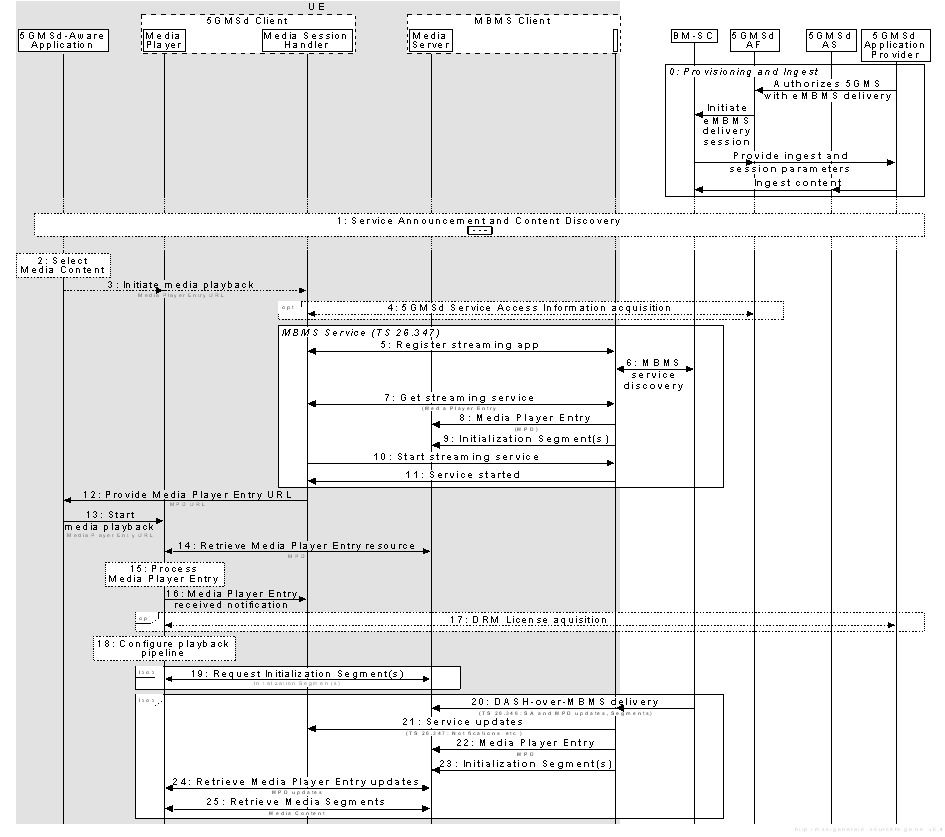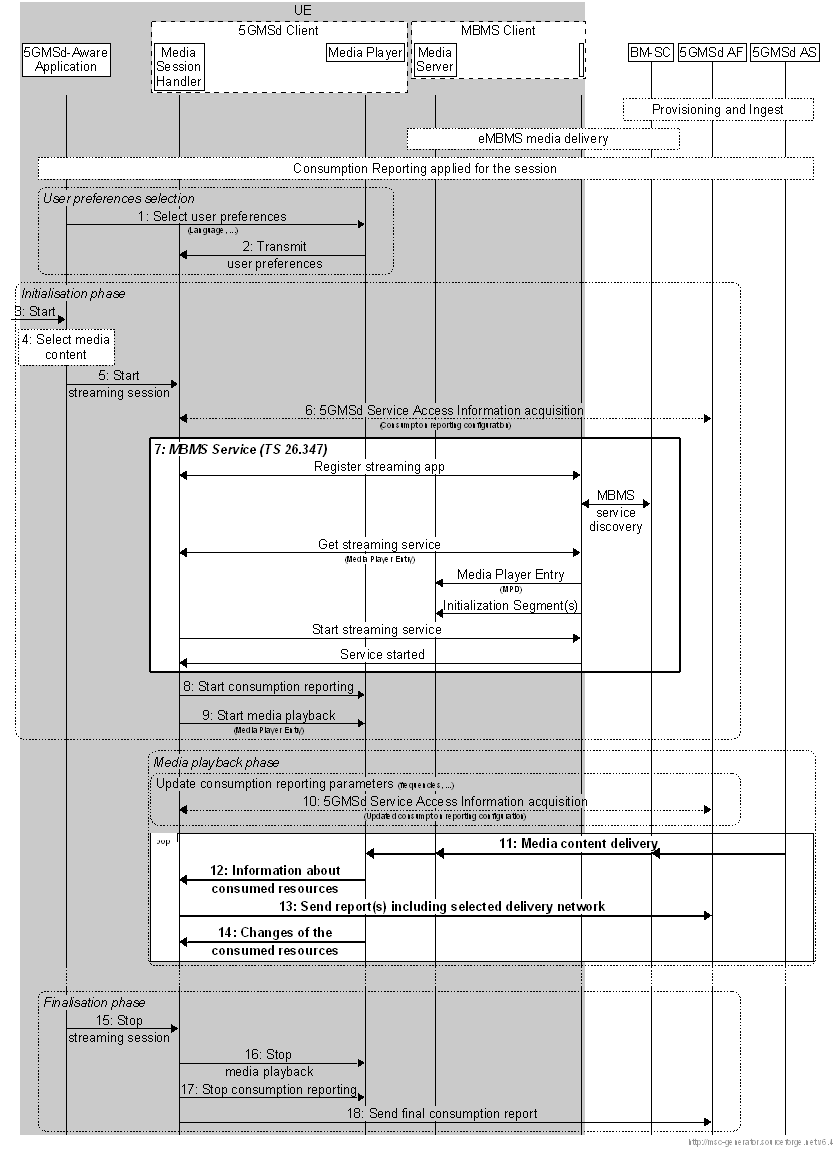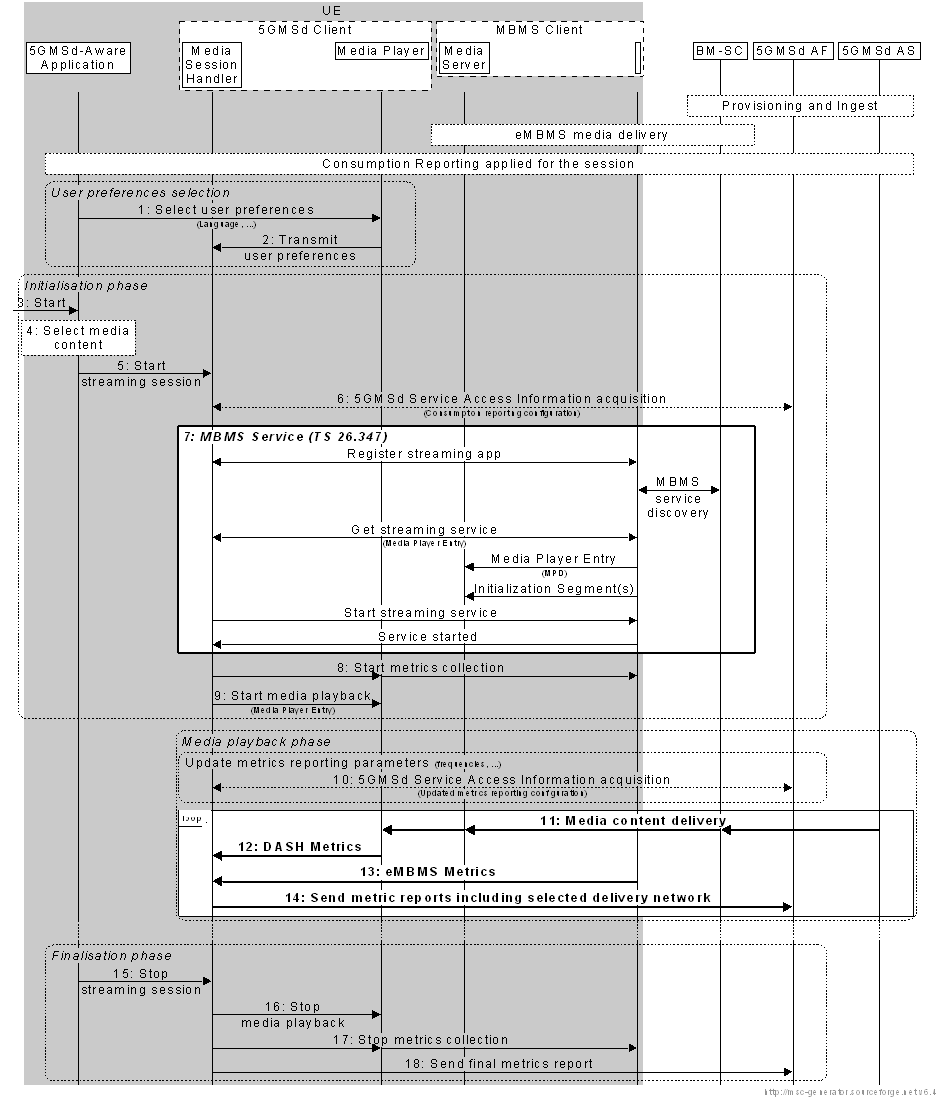Content for TS 26.501 Word version: 18.0.0
1…
4…
4.2…
4.2.2…
4.3…
4.5…
4.6…
4.7…
5…
5.2…
5.3…
5.3.2
5.4…
5.5…
5.5.3…
5.6…
5.7…
5.7.3
5.7.4…
5.8
5.9…
5.10…
5.10.5
5.10.6
5.11…
6…
6.2…
6.3…
6.5…
6.8…
7…
8…
8.2
A…
A.3…
A.5…
A.7…
A.9
A.10
A.11
A.12
A.13
A.14
A.15
B…
B.3
C…
C.3
C.4
C.5
D…
5.10 5GMS via eMBMS
5.10.1 General
5.10.2 Procedures for 5GMS content delivered exclusively via eMBMS
5.10.3 5GMS Consumption Reporting procedures for eMBMS
5.10.4 5GMS Metrics Reporting procedures for eMBMS
...
...
5.10 5GMS via eMBMS |R17| p. 68
5.10.1 General p. 68
This clause defines procedures for different use cases and scenarios when 5GMS is using eMBMS for delivery as introduced in clause 4.6.
5.10.2 Procedures for 5GMS content delivered exclusively via eMBMS p. 68
In this case, 5GMS media data is exclusively delivered via eMBMS, i.e. media content is not delivered via reference point M4d, but only via MBMS User Services. The 5GMSd Client acts as an MBMS-Aware Application.
The call flow in Figure 5.10.2-1 extends the call flow defined in clause 5.3.2 to address the delivery of 5GMS media data exclusively via eMBMS. Aspects specific to this use-case are indicated in bold.

Figure 5.10.2-1: High-level procedure for DASH content delivery via eMBMS
(⇒ copy of original 3GPP image)
(⇒ copy of original 3GPP image)
Prerequisites (step 0):
- The 5GMSd Application Provider has provisioned the 5G Media Streaming System, including content ingest and the authorization to distribute 5GMS content via eMBMS.
- The 5GMS AF has informed the BM-SC about the availability of 5GMS content by provisioning an MBMS service and has obtained relevant information from the eMBMS Service Announcement (such as the MBMS service identifier).
- The BM-SC is ingesting content from the 5GMS AS, using either pull mode or push mode.
- The BM-SC has broadcast the MBMS Service Announcement, including an indication that the content is 5GMS content.
Step 1.
The 5GMSd-Aware Application triggers the Service Announcement procedure and the 5GMS Service and Content Discovery procedure at reference point M8.
Step 2.
A media content item is selected.
Step 3.
The 5GMSd-Aware Application triggers the 5GMSd Client to start media playback. The Media Player Entry is provided to the 5GMSd Client.
Step 4.
If the 5GMS-Aware Application has received only a reference to the Service Access Information (see step 1), the Media Session Handler interacts with the 5GMSd AF to acquire the whole Service Access Information. This includes relevant information from the eMBMS Service Announcement (such as the MBMS service identifier) in order to bootstrap reception of the MBMS service.
Step 5-11.
The Media Session Handler acts as an MBMS-Aware Application and initiates service acquisition. For details, see TS 26.347. This establishes a transport session for the MPD and the Content.
Step 12.
The Media SessionHandler provides the MPD URL to the Media Player either directly or through the 5GMSd-Aware Application.
Step 13.
The Media Player is invoked to start media access and playback.
Step 14.
The Media Player retrieves the Media Player Entry resource (an MPD) from the proxy Media Server.
Step 15.
The Media Player processes the retrieved MPD. It determines, for example, the number of transport sessions needed for media acquisition. The Media Player should be able to use the MPD information to initialize the media pipelines for each media stream (see step 18). When DRM is used (see step 17) the MPD should also contain sufficient information to initialize the DRM client.
Step 16.
The Media Player notifies the Media Session Handler about the start of a new downlink media streaming session. The notification may include parameters from the MPD.
Step 17.
Optional: The Media Player acquires any necessary DRM information, for example a DRM License.
Step 18.
The Media Player configures the media playback pipeline.
Step 19.
The Media Player retrieves initialization segment(s) referenced by the MPD.
Step 20-25.
Content is delivered using DASH-over-MBMS. Session Announcement updates are provided to the MBMS Client as necessary. MPD updates and Segments are pushed to the media server. The Media Player retrieves media segments from the proxy Media Server according to the MPD and forwards them to the appropriate media rendering pipeline.
5.10.3 5GMS Consumption Reporting procedures for eMBMS p. 70
In this case, 5GMS consumption reporting is used to report consumption of 5GMSd content via an eMBMS service.
The call flow in Figure 5.10.3-1 extends the call flow defined in clause 5.6.1 to address consumption reporting. Aspects specific to this use-case are indicated in bold.

Prerequisites (step 0):
- The 5GMSd Application Provider has provisioned the 5G Media Streaming System, including content ingest, consumption reporting and the permission to distribute 5GMS content via eMBMS.
- The BM-SC is ingesting content from the 5GMS AS, using either pull mode or push mode.
- eMBMS media delivery is established.
- Consumption reporting is established.
Step 1.
The first phase is initialisation.
The 5GMSd-Aware Application selects/changes the user preferences.
Step 2.
The Media Player transmits consumption reporting user preferences to the Media Session Handler.
Step 3.
The second phase is media playback.
When media is playing, the consumption reporting parameters may be updated by the 5GMSd AF.
The 5GMSd-Aware Application is started.
Step 4.
A media content item is selected.
Step 5.
The 5GMSd-Aware Application triggers the Media Session Handler to start content playback. The Media Player Entry is provided.
Step 6.
If the 5GMS-Aware Application has received only a reference to the Service Access Information, the Media Session Handler interacts with the 5GMSd AF to acquire the whole Service Access Information. This includes a client consumption reporting configuration including parameters such as reporting frequency.
Step 7.
The MBMS service is initiated.
Step 8.
The Media Session Handler triggers consumption reporting in the Media Player.
Step 9.
The Media Session Handler starts the Media Player with the Media Player Entry.
Step 10.
When media is playing:
The Media Session Handler acquires updated Service Access Information from the 5GMSd AF including updated consumption reporting parameters.
Step 11.
The last phase is to stop the media:
Media content is accessed through different networks, possibly via eMBMS or unicast.
Step 12.
The Media Player transmits information about the media streaming resources consumed to the Media Session Handler, including the source of the media.
Step 13.
The Media Session Handler regularly sends consumption report(s) to the 5GMSd AF, including information about the delivery network from which the media was acquired.
Step 14.
The Media Player provides an update to the Media Session Handler about the consumed media streaming resources, for example a change in the delivery network.
Step 15.
The 5GMSd-Aware Application triggers the Media Session Handler to stop content playback.
Step 16.
The Media Session Handler stops the Media Player.
Step 17.
The Media Session Handler stops consumption reporting in the Media Player.
Step 18.
The Media Session Handler may send final consumption report(s) to the 5GMSd AF.
5.10.4 5GMS Metrics Reporting procedures for eMBMS p. 72
In this case, 5GMS metrics reporting is used to report 5GMS and eMBMS metrics to the 5GMSd AF.
The call flow in Figure 5.10.4-1 extends the call flow defined in clause 5.5.3 to address metrics reporting. Aspects specific to this use-case are indicated in bold.

Prerequisites (step 0):
- The 5GMSd Application Provider has provisioned the 5G Media Streaming System, including content ingest, metrics reporting and the permission to distribute 5GMS content via eMBMS.
- The BM-SC is ingesting content from the 5GMS AS, using either pull mode or push mode.
- eMBMS media delivery is established.
- Metrics reporting is established.
Step 1.
The first phase is initialisation.
The 5GMSd-Aware Application selects/changes the user preferences.
Step 2.
The Media Player transmits metrics reporting user preferences to the Media Session Handler.
Step 3.
The second phase is media playback.
When media is playing, the metrics reporting parameters may be updated by the 5GMSd AF.
The 5GMSd-Aware Application is started.
Step 4.
A media content item is selected.
Step 5.
The 5GMSd-Aware Application triggers the Media Session Handler to start content playback. The Media Player Entry is provided.
Step 6.
If the 5GMS-Aware Application has received only a reference to the Service Access Information, the Media Session Handler interacts with the 5GMSd AF to acquire the whole Service Access Information. This includes a client metrics reporting configuration including parameters such as reporting frequency.
Step 7.
The MBMS service is initiated.
Step 8.
The Media Session Handler triggers metrics collection by the MBMS Client and by the Media Player.
Step 9.
The Media Session Handler starts the Media Player with the Media Player Entry.
Step 10.
When media is playing:
The Media Session Handler acquires updated Service Access Information from the 5GMSd AF including updated metrics reporting parameters.
Step 11.
The last phase is to stop the media:
Media content is accessed through different networks, possibly via eMBMS or unicast.
Step 12.
The Media Player provides DASH metrics to the Media Session Handler.
Step 13.
The MBMS Client provides MBMS metrics to the Media Session Handler using MBMS-API-C.
Step 14.
The Media Session Handler regularly sends metrics report(s) to the 5GMSd AF, including information about the delivery network from which the media was acquired.
Step 15.
The 5GMSd-Aware Application triggers the Media Session Handler to stop content playback.
Step 16.
The Media Session Handler stops metrics collection in the MBMS Client and the Media Player.
Step 17.
The Media Session Handler stops metrics reporting.
Step 18.
The Media Session Handler may send final metrics report(s) to the 5GMSd AF.